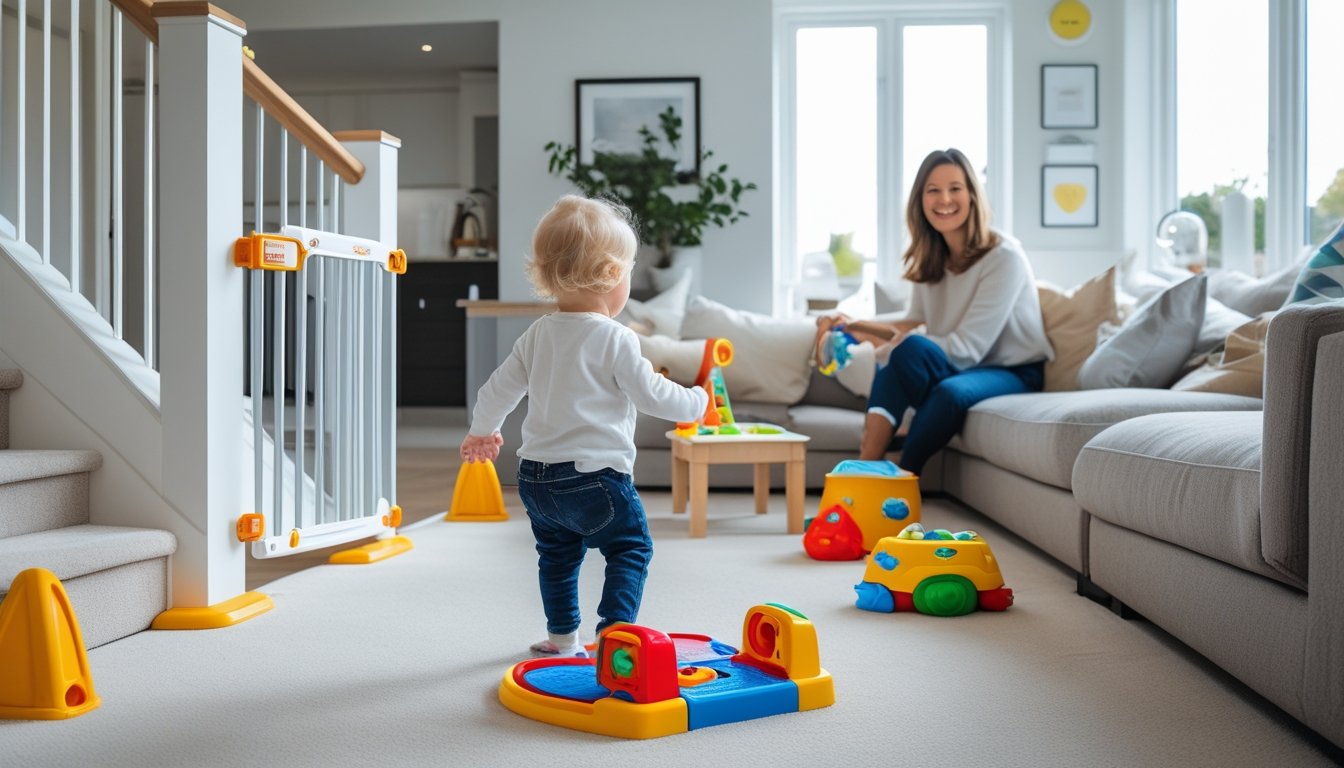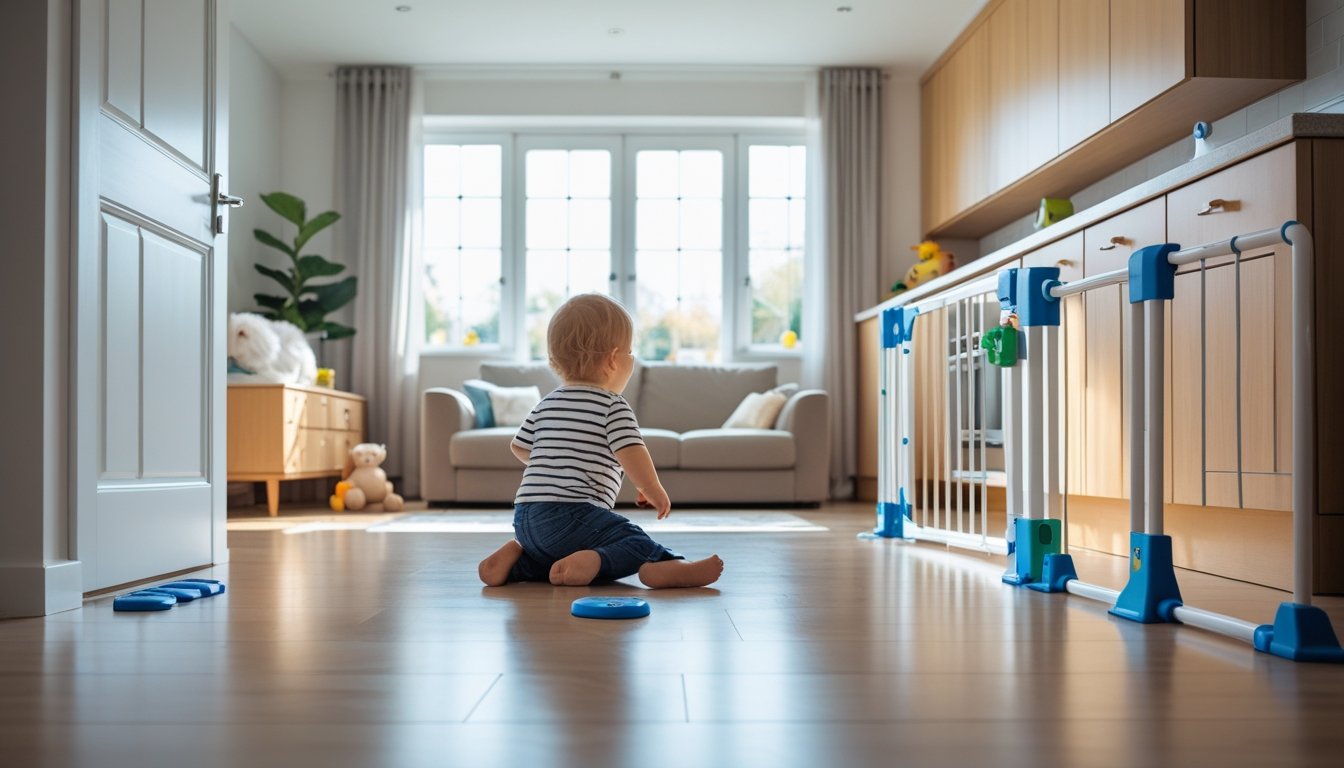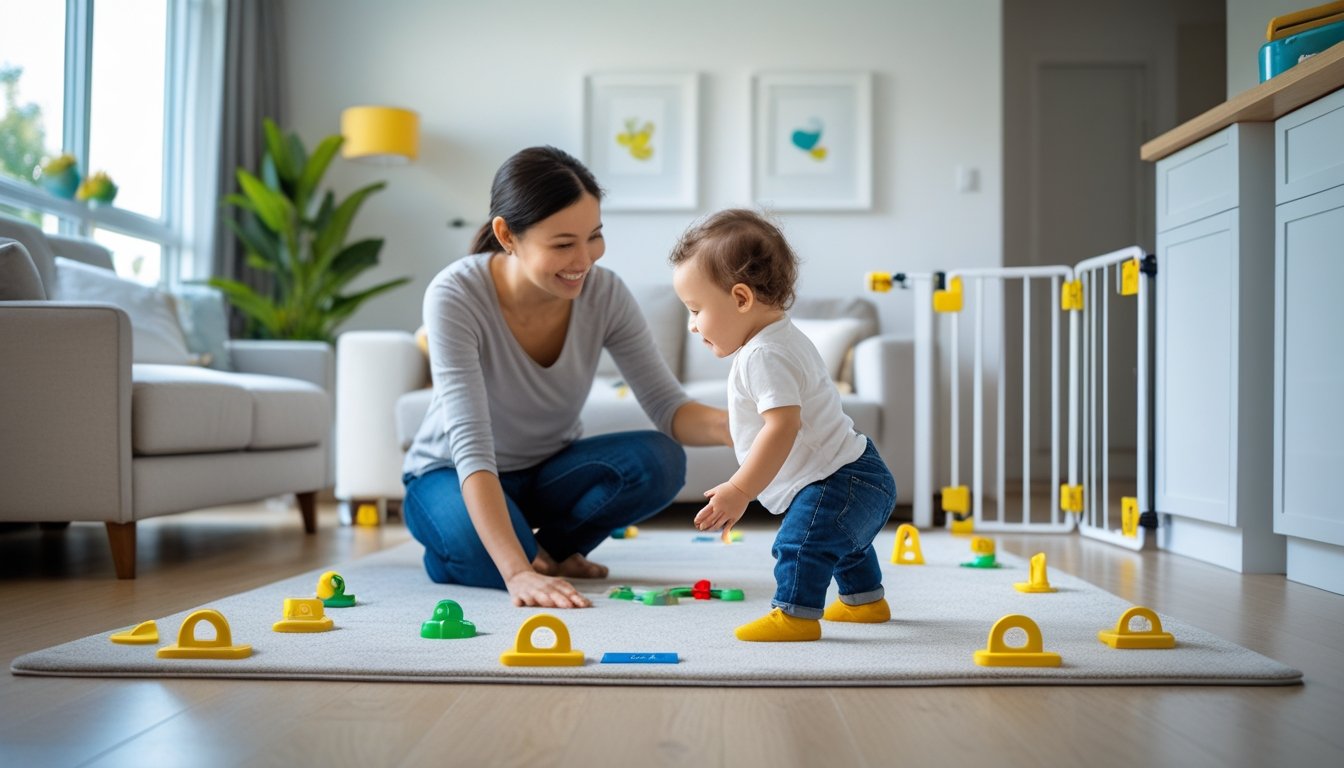Late updated: 14 Jul 2025 18:07
Written by: Elena Prescott
Guide To Childproofing Your Home Securely: Essential Tips and Techniques
Welcoming a little one into our lives is indeed a joyous occasion, but with it comes the paramount responsibility of ensuring a safe environment. Childproofing your home is an essential step in protecting children from potential household hazards, enabling them to explore safely and giving us peace of mind. As they grow, their curiosity propels them to crawl, climb, and investigate every nook and cranny. This innate desire to explore requires us to be vigilant, preparing our homes accordingly to mitigate risk while allowing them the freedom to learn and discover.

To establish a child-friendly environment, it's crucial to address potential dangers in each area of our home. Key elements such as installing safety gates, securing furniture, anchoring freestanding appliances, and utilising door stops can significantly reduce the likelihood of accidents. Additionally, paying attention to each room’s unique hazards helps tailor our approach to meet specific needs, ensuring we provide a comprehensive haven for our children.
Through thoughtful planning and implementation, we can transform our homes into safe sanctuaries where our little explorers can thrive. Our guide provides practical advice, insights, and room-by-room solutions to achieve a childproofed home efficiently and effectively.
Key Takeaways
- Prioritise and implement essential safety measures throughout the home.
- Address each room's specific hazards for comprehensive childproofing.
- Equip ourselves with reliable tips and solutions for confident child safety management.
Fundamental Principles of Childproofing Your Home

Creating a secure environment for children involves understanding key differences between childproofing and babyproofing, assessing hazards by developmental stages, and implementing essential safety strategies. These principles ensure our homes are safe spaces for children to explore and grow.
Childproofing versus Babyproofing: Key Differences
Childproofing and babyproofing, while often used interchangeably, address different safety needs based on a child’s age and abilities. Babyproofing focuses on infants, typically up to 12 months, who are learning to crawl and explore their surroundings. We aim to secure areas like cribs and nappy-changing stations and ensure items like small toys and plastic bags are out of reach.
Childproofing, on the other hand, targets children beyond infancy, encompassing a broader range of hazards as their mobility and curiosity increase. This includes locking cabinets, securing heavy furniture, and ensuring electrical outlets are covered. Our approach must evolve as the child grows, catering to new safety challenges at each developmental milestone. Understanding these key differences aids us in creating a progressively safer household environment.
Assessing Hazards by Developmental Stage
Assessing home hazards requires us to consider the unique behaviors and developmental milestones of children. At the crawling stage, children tend to investigate by putting objects in their mouths. Ensuring choking hazards are removed and sharp edges are cushioned is crucial. As children begin walking, staircases become significant areas of concern, necessitating gates and secure handrails.
Preschoolers introduce new challenges as they become adept at climbing and reaching higher spots. We must relocate breakables and cleaners to inaccessible areas. Evaluating hazards by developmental stage not only ensures relevant safety measures but also provides us with the knowledge to adjust our strategies as children grow, ensuring consistent safety.
Essential Childproofing Strategies Every Home Needs
Implementing effective childproofing strategies requires attention to detail. We need to start by securing furniture to walls to prevent tipping. Installing safety gates at staircases and doorways, especially those leading to potentially dangerous areas like kitchens, is imperative.
Covering electrical outlets with tamper-resistant covers prevents potential electric shocks. Keeping medications, cleaning solutions, and small objects out of reach enhances safety. Creating a safe sleeping environment for babies with firm mattresses and fitted sheets devoid of extra bedding reduces the risk of suffocation. These strategies ensure our homes remain safe havens for our growing children while allowing us peace of mind.
Room-by-Room Childproofing Solutions
Ensuring your home is a safe haven for children involves addressing the unique challenges and hazards presented by each area. By focusing on specific risk factors per room, we can effectively minimise dangers and ensure peace of mind for everyone. Here’s how we can secure various areas of our home.
Living Room and Common Areas: Preventing Accidents
Living rooms are where we often spend the most time together, which means they need to be particularly safe. Securing furniture with wall anchors prevents tipping, which is crucial for bookshelves and televisions. Outlet covers are essential for protecting little fingers from electrical shocks.
Additionally, corner guards or corner cushions on tables and shelves can protect children from sharp edges. Cord clips help keep curtain and blind cords out of reach, reducing the risk of strangulation. By placing safety gates at stair entrances, we can prevent unsupervised access to dangerous areas.
Kitchen Safety: Solutions for High-Risk Zones
Kitchens are full of potential hazards for children, from sharp tools to hot surfaces. Installing stove guards and stove knob covers can prevent accidental burns. Cabinet locks and drawer locks are highly effective in keeping dangerous items, like knives and cleaners, secure. We can also use magnetic locks for a more discreet method.
It is important to store choking hazards, such as small kitchen accessories, out of reach. An anti-scald device on taps ensures the water temperature remains child-safe. By moving cleaning supplies and chemicals to high cabinets with safety latches, we further reduce risks.
Bathroom and Laundry: Preventing Water and Chemical Hazards
Bathrooms and laundry rooms pose risks, primarily due to water and chemicals. Toilet locks prevent accidents involving water, while non-slip mats are crucial for avoiding slips in wet areas. In laundry rooms, keep small items like detergent pods out of reach to prevent choking hazards.
Emergency contact numbers should be easily accessible in case of any incidents. Childproofing products like door locks can prevent unsupervised access to these areas. Consider using devices that limit the amount of water in the bath to prevent drowning, even in shallow water.
Securing Bedrooms: Creating Safe Sleeping Spaces
A child’s bedroom should be a sanctuary, free from hazards. Cribs should meet the latest safety standards, with slats close enough together to prevent entrapment. Using baby monitors allows us to keep an eye on infants from a distance. Window guards or window locks ensure windows cannot be opened wide enough for a child to fall through.
Organising toys and small items helps in reducing clutter and potential choking hazards. Securing tall furniture with wall anchors is important for avoiding tipping accidents. Finally, nighttime safety lights can prevent trips and falls after dark.
Making Staircases and Windows Secure
Staircases are one of the most significant hazards in multi-storey homes. Baby gates at the top and bottom effectively prevent falls. Make sure gates are securely installed and have a locking mechanism.
For windows, installing window guards or window locks is vital. These tools prevent a child from opening windows further than a few inches. Don't forget about securing cords from blinds to reduce risks of entanglement.
Outdoor Areas and Pool Safety Measures
Outdoor spaces offer particular challenges and require robust safety measures. If your home has a pool, erecting fencing with a self-latching gate is a legal requirement in many areas. Pool safety isn't just about physical barriers; always keep floatation devices handy and never leave children unattended.
Covering outlets in outdoor areas and using non-slip surfaces reduces risks of shocks and falls. Garden chemicals should be stored away from children's reach, and external equipment like barbecues and tools need secure storage. Outdoor stairs and steps can benefit from safety gates as well.
Frequently Asked Questions

Childproofing your home involves careful planning and execution to keep our children safe. From compiling thorough checklists to choosing the most effective products, each step is critical to designing a secure environment.
What items should be included in a comprehensive baby-proofing house checklist?
A solid checklist might contain cabinet locks, outlet covers, safety gates, corner protectors, and furniture anchors. It's essential to assess each room individually for specific hazards and include childproofing devices that address these risks to create a safer home environment.
How can one identify the most reliable baby-proofing house services?
We suggest looking for services with positive customer reviews, professional certification, and transparent pricing. Additionally, recommendations from parenting groups or online forums can help identify reputable providers. Engaging with a consultant who offers an initial home evaluation can also be beneficial.
Which baby-proofing products are considered the best for ensuring home safety?
Reliable products often come from trusted brands with a reputation for quality and safety. Examples include magnetic cabinet locks, adjustable safety gates, and shock-resistant outlet covers. Checking for products with safety certifications or those reviewed positively by a broad range of parents is advisable.
Could you list the top five tips for effective childproofing of a home?
- Secure heavy furniture to avoid tipping.
- Install gates at the top and bottom of staircases.
- Keep small and sharp objects out of reach.
- Use plug covers to prevent electrical shocks.
- Regularly review and adjust safety measures as children grow.
Where can one find a user-friendly baby-proofing checklist in a printable format?
Many parenting websites and organisations offer printable checklists. Websites focused on family safety, such as those by health institutions or child product manufacturers, often provide detailed and easily accessible lists. These resources can be valuable for ensuring comprehensive home safety.
Are there reputable sources offering a free baby-proofing kit for new parents?
Certain health organisations and local community centres may provide free kits to new parents. It's worth checking with local health departments or parenting support groups for available resources. Additionally, some retailers may offer promotional kits with purchases of childproofing products.
